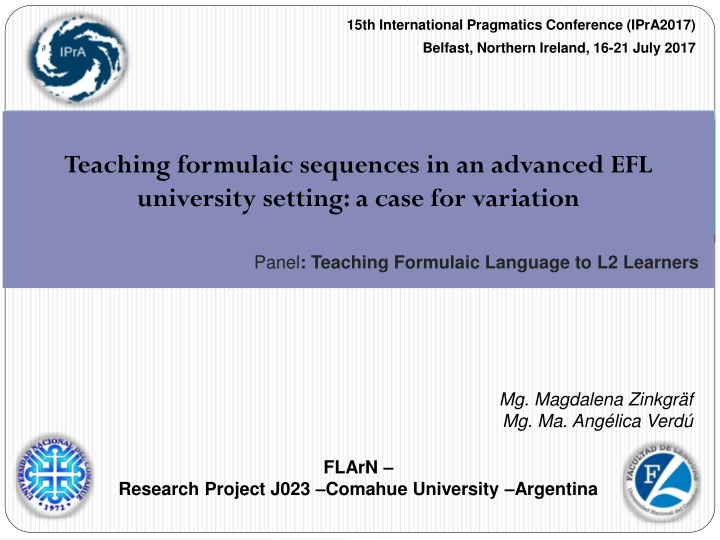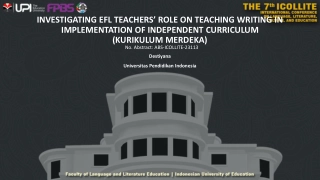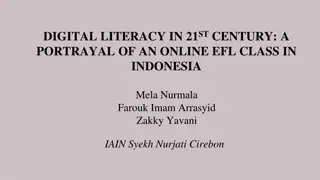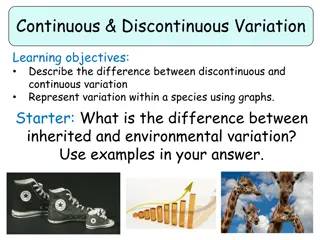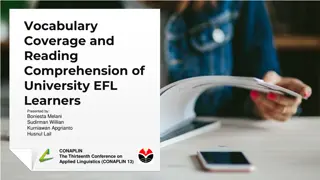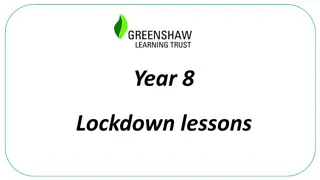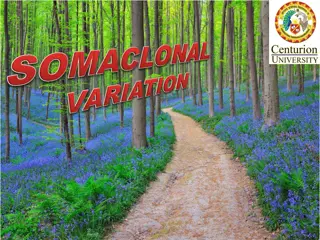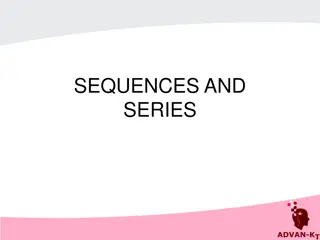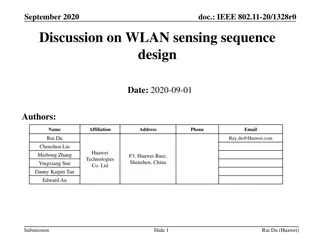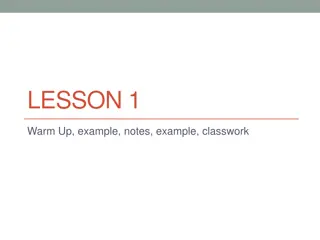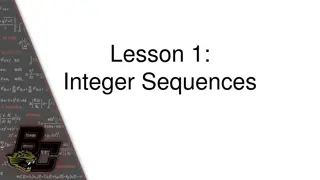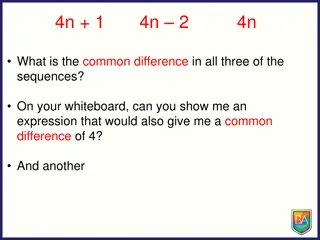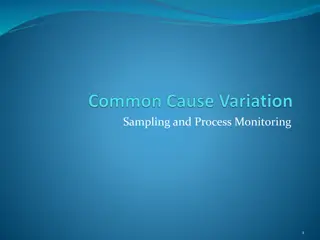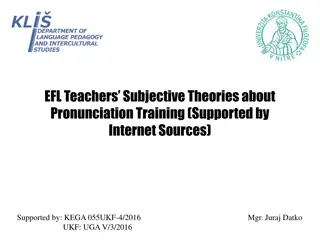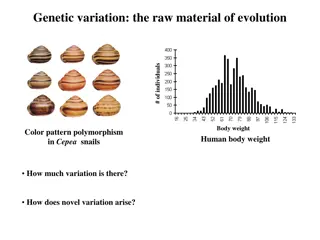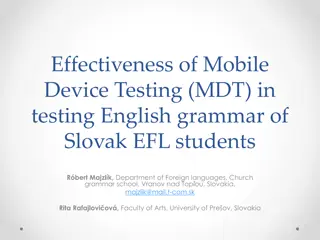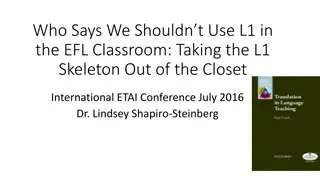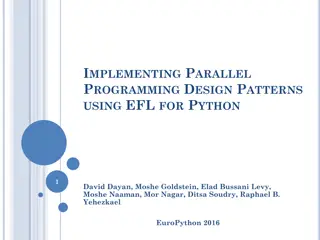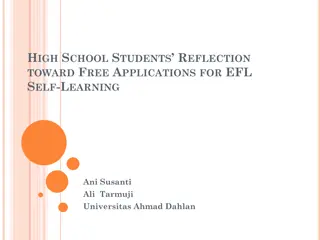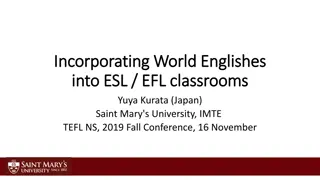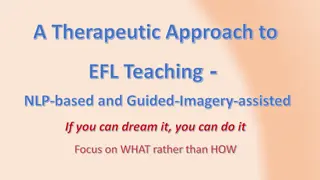Teaching Formulaic Sequences in EFL University Setting: A Case for Variation
This study at the 15th International Pragmatics Conference explores instruction on formulaic sequences in an advanced EFL university context, assessing effects on learner acquisition and production. Research questions examine vocabulary form-focused instruction, variations in learner versions, and the duration of instructional effects.
Download Presentation

Please find below an Image/Link to download the presentation.
The content on the website is provided AS IS for your information and personal use only. It may not be sold, licensed, or shared on other websites without obtaining consent from the author.If you encounter any issues during the download, it is possible that the publisher has removed the file from their server.
You are allowed to download the files provided on this website for personal or commercial use, subject to the condition that they are used lawfully. All files are the property of their respective owners.
The content on the website is provided AS IS for your information and personal use only. It may not be sold, licensed, or shared on other websites without obtaining consent from the author.
E N D
Presentation Transcript
15th International Pragmatics Conference (IPrA2017) Belfast, Northern Ireland, 16-21 July 2017 Teaching formulaic sequences in an advanced EFL university setting: a case for variation Panel: Teaching Formulaic Language to L2 Learners Mg. Magdalena Zinkgr f Mg. Ma. Ang lica Verd FLArN Research Project J023 Comahue University Argentina
Introduction A shift towards teaching strings of words Formulaic sequences FSs (Wray, 2002) Their pervasiveness in native language, and Difficulties for NNSs the case for instruction Research on the effects of FS Instruction Ab Manan (2014a y b), Alhassan andWood (2015), olovi -Markovi (2012), Jones and Haywood (2004), Lewis (2009),and Peters and Pauwels (2015).
Objectives: To assess the effects of a) different types of instruction on FS acquisition in b) gap-completion tasks and c) spontaneous written production To analyse the variations produced by learners of a set of formulaic sequences (FSs) in search of evidence of FS acquisition process
The context & the Study Participants 3 cohorts of advanced (C2) university students taking Lengua Inglesa III at the Teacher-training Universidad del Comahue N= 39 All learners lent their consent to the study and signed their written permissions to be part of the experience programme at FADEL,
Research questions 1. Does vocabulary form-focused instruction of FSs have an effect on a) number of FSs recalled and b) number of FSs used spontaneously? 2. Does the type of focused instruction of FSs have an effect on a) number of FSs recalled and b) number of FSs used spontaneously? 3. How similar /different are learners versions to the target FSs? For 1 and 2 above, a fourth research question applies, 4. If so, how long after the intervention does the effect continue to exist?
Methods Treatment conditions EG1 (2015): focus on form (input flood and enhancement) + data analysis + gap-filling tasks + dictogloss (Waynryb, 1990) - 7 hours; N: 13 EG2 (2017): focus on form (awareness-raising + 2 dictogloss tasks) 6 hours; N:19 Control group (no instruction): text + tasks in coursebook; N: 7 Data collection instruments: Pretest 3 Posttests (1 immediate and 2 Delayed) Essay writing task
Selecting the nine TFSs PRE TEST: Whole sentences extracted from native databases and used as contexts to trigger learners use of the TFSs (Target Formulaic Sequences) E.g.: I m not sure to what e_________ you agree with Qian s theory. FSs worth teaching: their relative frequency in native language their novelty for this particular learning environment 1. the prospect of 2. outside the constraints of 3. without the inconvenience(s) of 4. ignore at (someone s) peril 5. (be) oblivious to sth 6. cloud (my) appreciation of 7. (be) at once obvious and surprising 8. be subject to 9. for all the good [ ] (do) (them)
Data collection instruments C-test tasks in three delayedpost-tests Example: The water crisis has revealed that groundwater is part of a system of powerful hydrological interactions that we i____________________________________. We should reconsider and work for a better future. (COCA) CORRECT NOANSWERS ATTEMPTED FSs spontaneous production of the TFSs in written practical assignments. Record of instances per learner across tasks felicitous/infelicitous productions (Lewis,2009)
Findings: Revisiting our research questions RQ1: Does vocabulary form-focused instruction of FSs have an effect on a) number of FSs recalled and b) number of FSs used spontaneously? a) CORRECT ANSWERS PT1 EG1 (%) CG (%) EG2 (%) 76,05 0 19,0 PT2 69,9 0 42 PT3 63,63 5,6 --- 29 instances of 7 FSs 11/13 participants 3 practical assignments 0 instances 50 instances of 9 FSs 15 /19 participants 5 practical assignments b) SPONTANEOUS PRODUCTIONS 0/7 participants 3 practical assignments
RQ2 Does the type of focused instruction of FSs have an effect on a) number of FSs recalled and b) number of FSs used spontaneously? a) Posttests Both types of instruction have yielded gains in comparison to CG EG2 had an initially poor performance in test completion (PT1) (instruction type- effect) EG1 FONF EG2 DICTOGLOSS Text reconstructions: use of TFSs in context gap-filling tasks, transformations & dictogloss Use of TFSs in meaning- form mappings training for Posttests Better performance in spontaneous production Better performance in c-tests
RQ2 Does the type of focused instruction of FSs have an effect on a) number of FSs recalled and b) number of FSs used spontaneously? EG2 (%) CG (%) Variations EG1 (%) 22,6 57,1 Pt1 12,83 27,8 30,2 Pt2 21,38 24,1 -- Pt3 27,26 Variations (attempted FSs) increase in number with time (except for CG more No Answers Much higher rates of variation for EG2 (similar rates across time?) EG1 loss of correct answers affects percentage of variations (higher): less accurate retrieval of SFs but still towards formulaicity (morpho-syntax) Missing final prepositions (test-effect?)
RQ2 Does the type of focused instruction of FSs have an effect on a) number of FSs recalled and b) number of FSs used spontaneously? b) Spontaneous use EG1: 29 instances of 7 TFSs X The prospect of X For all the good it did Most used TFS: Be oblivious to EG2: 50 instances of 9 TFSs Most used TFS: Be oblivious to Cloud our appreciation of Least used TFS: For all the good it did Ignore at our (own) peril Least used TFS: Outside the constraints Within the inconvenience of
Findings: Attempted FSs RQ3. How similar /different are learners versions to the TFSs? Variations: a) Posttests TFS LEXICAL REPLACEMENTS the surprise of (EG1 LIiii11) / the idea of (PT1 & 2 EG1 LIiii22) & (EG2 LIiii33) / the feeling of 1. The prospect of (EG1 LIiii11) thinking of (EG1 LIiii19)/through (EG1 LIiii9) 1. Without the without the PROBLEMOF (PT2)(EG1 LIiii22); inconvenience of 1. Be at once adj and at the same time (pt1,2,&3 (EG1 LIiii3));*at BOTH (EG1 LIiii4);APPARENTLY (EG1LIiii19) adj sued (2) (EG1 LIiii19); SUGGESTED IN (PT1) (EG1 LIiii11); SUBJECTED TO (PT2) (EG1 1. Be subject to LIiii4) Difficulties in complying with the grammatical and lexical requirements of TFS consequences to (EG1 LIiii4), contributed to (EG1 LIiii19), and considered (EG1 LIiii10). Grammatically and lexically appropriate modification: conditioned (EG1 LIiii11)
Variations: a) Posttests Grammatical analysis + initial letter (Be at once+adj+and+adj apparently (EG1 LIiii19) Use of a single preposition instead of the whole sequence: condensation of meaning of TFS (e.g.: outside the constraints of outside; (EG2 LIiii37); over (EG1 LIiii9) without the inconvenience of without (EG2 LIiii26) CG variations: less related in meaning and form to TFSs (attention/awareness) (E.g.: implemented and thinking about (LIiiiC1);, submitting (LIiiiC8) Individual choices which are repeated as answers across tests MORPHO-SYNTACTIC VARIATIONS Alteration of the number marking of the noun (E.g.: inconveniences (EG2 LIiii32); prospects (EG1 LIiii13) (correct in the corpora consulted) Modifications in the choice of preposition errors, as in *without the constraints of (EG2 LIiii28) / (PT2) (EG1 LIiii15)= blends: other TFS -- the identical structure underlying both (Prep+the+Noun+of)) ANALYTIC (e.g.: Clouded my appreciation ON (EG2 LIiii36)
b) Variations in spontaneous use Few instances of attempted FSs in both EG1 and EG2 Yet,these waves of satisfaction and excitement cloud our VISION of reality,and make us oblivious to the possible downsides that travelling may entail (EG2 LIiii29) This may possibly lead to cloud their VIEWS and stay in bed all day long making no effort to achieve their tasks.(EG2 LIiii38) *Whenever we access the internet,we may well face a number of risks OF which we seem to be oblivious,especially children.(EG2 LIiii33) Some infelicitous occurrences: *This misuse of technology may lead users to be subject to criminal acts. (EG2 LIiii43) *We can meet people from all around the world outside the constraint of travelling abroad.(EG2 LIiii28) *Innovative technologies can be at once helpful and enjoyable.(EG2 LIiii28) *[ ] we are able to distinguish between the characteristics of our personality that we should keep and those ones that we should be oblivious to.(EG1 LIiii11)
DISCUSSION & CONCLUSIONS Variations encountered in learners productions in function words and lexical items Postests:most variations occurred (test-effect?) Extent to which variations are included is independent of number of words the FS is composed of Most spontaneous FS uses have been felicitous and correct as regards form,meaning and use. Evidence of participants awareness of the patterns of use of the TFSs in this study (ANALYSIS? OR RETRIEVEDWHOLE?) Some FS imprint left in learners minds incomplete retrieval: attempt to repair the blanks of missing components (alternatives: same part of speech)
DISCUSSION & CONCLUSIONS (Cont.) TFS memory apparently stored around content words in the FS The rest: unimportant learners probably rely on their ability to retrieve them whole afterwards. Formulaicity lies in the phrases themselves: not in learners ability to retrieve them whole Formulaicity: observed in the syntactic make-up of the phrases produced by learners FS form seems to be negatively affected by recall of function words Formulaicity in L2 learning NOT only related to FS successful automatization Attempts and variations play a role A more process-oriented view of the development of their formulaic competence
REFERENCES Ab Manan, N.A., P. Jaganathan and A. Pandian. (2014a) The benefits of formula instruction in enhancing EAP learners academic writing performance .Journal of English Language and Literature,Vol.2,(1) pp.141-153 Ab Manan, N.A., P. Jaganathan and A. Pandian. (2014b) Enhancing academic writing performance through direct instruction of the academic formulas . International Journal of research in education methodology Vol.6, N 2,pp.850-861 Alhassan, L. and D. Wood. (2015) The effectiveness of focused instruction of FSs in augmenting L2 learners' academic writing skills:A quantitative research study ,Journal of English forAcademic Purposes 17,pp.51-62 olovi -Markovi , J. (2012) The effects of explicit instruction of FSs on second-language writers. PhD Thesis (Manuscript), Universidad de content.lib.utah.edu/utils/getfile/.../etd3/.../2092.pdf Davies, Mark. (2008-) The Corpus of Contemporary American English: 520 million words, 1990-present. Retrieved from http://corpus.byu.edu/coca/. Jones, M. and S. Haywood. (2004) Facilitating the acquisition of FSs . In N. Schmitt, (Ed.), Formulaic sequences,Philadelphia:John Benjamins Publishing.pp.269-300 Lewis, M. (2009) The Idiom Principle in L2 English: Assessing elusive formulaic sequences as indicators of idiomaticity, fluency and proficiency. Saarbr cken: VDM Verlag Dr. M ller. Peters, E. and P. Pauwels. (2015) Learning academic formulaic sequences . Journal of English for Academic Purposes 20,pp.28-39 Wajnryb, R. (1990) Grammar dictation. Oxford, Oxford University Press Wray, A. (2002) Formulaic language and the lexicon. Cambridge: Cambridge University Press. Utah- Retrieved 29/3/2016, at
